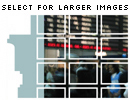



Social dynamics are often
difficult to comprehend. So it is fitting that Penn Station, the busiest hub
in New York's vast network of public transportation,
is hidden from view beneath a non-descript building. But the imperceptibility
of this space serves as more than a metaphor for the conceptual difficulty
of understanding public activity. The architecture of Penn Station affords
few tangible opportunities for people to observe how their movement affects
others. And without such a perspective, it is difficult to appreciate
the value of public space, much less contribute to its development in any meaningful
way.
Congestion is among the many systemic problems that occur at Penn Station as
a result of people's inability to grasp the relationship between their movement
and the dynamics others. And neither the signage that is intended to direct
movement nor the spatial design of the station provide the type of information
that people require in order to deal with congestion and similar systemic problems.
The periodic arrival and departure updates that punctuate the station's static
signage do not adequately address people's needs as they arise. And the compartmentalization
of architectural space offers no perspective on
the interrelationships of the different systems of transportation that converge
at the station. Lack of attention to these dynamics fosters confusion and frustration
among many who use Penn Station, reactions that are all too often associated
with public space.
Technology is already in place, however, that could be repurposed to provide
people with the maps that they require in order to make efficient use of Penn
Station. And perhaps more important, this technology could enable new systems
of social interaction to emerge in response to people's future needs. All that
is required to repurpose this technology is an interface that allows people
to interact with a stream of information to which they currently have no access:
surveillance video.
Movement throughout Penn Station is already mapped dynamically on an ongoing
basis by hundreds of video cameras. This information is used to provide insight
into the activities of those who use the space. But the public currently has
no access to this insight. Feedback that could give people a perspective
on how their personal behavior affects that of others is restricted. This project
makes such feedback widely available. Information
that is captured by surveillance cameras is provided to people where and when
it is
needed.
Moreover,
the interface
that is used to convey such information also enables people to use personal
SMS-based technology, such as cell phones, to build a second level of
feedback on top of that which has already been extracted from the surveillance
video.
When used for tasks such as communicating one's location to a friend whom one
is trying to meet, or for entertaining oneself and others by creating and playing
location-oriented games, this project provides a useful new dimension to Penn
Station. The feedback loops that are created address more, however, than just
the practical concerns of those who use the space. Such feedback facilitates
emergent behavior. By providing access to information that is currently restricted
to those in positions of authority, the project gives people a framework with
which to develop new solutions to the problems they face. And because this
framework
is premised on open communication, it affords the high level of participation
that robust public activity demands.
Public space is often compromised when informational dimensions receive less
attention than their spatial counterparts. Penn Station is emblematic of such
neglect. This project addresses the issue by providing feedback. And in so
doing, it creates
an opportunity for the public to map their space in a new way.



 .
.